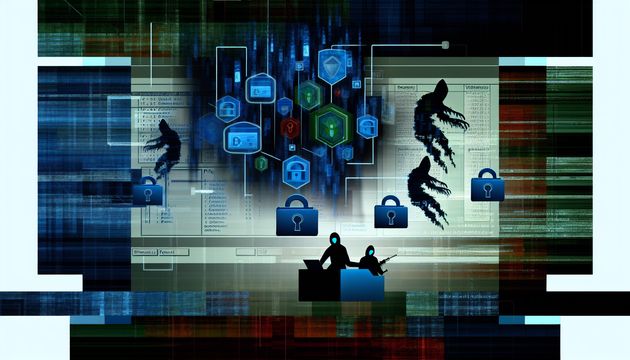
ThreatLocker: A Security-First Approach to Patch Management
ThreatLocker has redefined patch management by embedding a security-first mindset into its processes. At the heart of this approach is the integration of Zero Trust principles, which treat every change, including vendor patches, as potentially untrusted until verified. This is crucial in a landscape where cyber threats evolve rapidly, and vulnerabilities are often exploited within hours of their disclosure. By implementing pre-patch auditing, ThreatLocker ensures that patches are not blindly deployed, thereby reducing the risk of introducing new vulnerabilities.
Moreover, ThreatLocker enhances visibility and control over the patch management process, allowing security teams to quickly identify and quarantine vulnerable systems. This was evident during the CVE-2023-23397 zero-click vulnerability incident in Microsoft Outlook, where ThreatLocker users could swiftly manage the threat. By aligning patch deployment with an organization’s risk appetite and business priorities, ThreatLocker ensures that patches are deployed strategically, minimizing disruptions and maximizing security.
ThreatLocker’s Security-First Approach
Leveraging Zero Trust Principles
ThreatLocker’s patch management strategy is deeply rooted in the principles of Zero Trust, which assumes that every change, including vendor patches, is potentially untrusted until verified. This approach is crucial in today’s cybersecurity landscape, where threats evolve rapidly, and attackers often exploit vulnerabilities within hours of their disclosure. By integrating Zero Trust principles, ThreatLocker ensures that patches are not blindly deployed, reducing the risk of introducing new vulnerabilities. This method involves pre-patch auditing, which provides detailed reports on available patches, affected systems, and associated risks, thereby eliminating blind deployments.
Enhanced Visibility and Control
A key component of ThreatLocker’s security-first approach is providing enhanced visibility and control over the patch management process. This is achieved through real-time asset visibility, which allows security teams to identify all vulnerable instances within their environment quickly. For example, when the CVE-2023-23397 zero-click vulnerability in Microsoft Outlook was disclosed, ThreatLocker users could instantly flag systems with vulnerable Outlook versions and quarantine high-risk endpoints until patch validation was complete.
Precision Patch Management
Precision patch management is no longer a luxury but a necessity in modern cybersecurity strategies. ThreatLocker emphasizes the importance of aligning patch deployment with an organization’s risk appetite and business priorities. This involves controlled rollouts and testing, where patches are deployed to test groups or low-risk environments before a full production rollout. This method ensures that patched applications behave as intended post-update, integrating seamlessly with allowlisting policies.
Automation and Scheduling
Automation plays a critical role in ThreatLocker’s approach, allowing teams to automate routine patching while maintaining manual review gates for high-risk assets. This strategy is a practical application of the “assume breach” mindset, where organizations prepare for potential breaches by ensuring that their patch management processes are robust and efficient. ThreatLocker aims to have patches available to the public within 24-48 hours after the applications team catalogs the update, with priority given to high-risk applications.
Ringfencing Technology
ThreatLocker’s Ringfencing technology is a critical component of its security-first approach, providing an additional layer of protection even for fully patched applications. Ringfencing restricts what approved applications can access, such as files, scripts, or network resources, preventing lateral movement and living-off-the-land attacks. This technology ensures that even if an application is compromised, the attacker’s ability to exploit the system further is significantly limited.
Emergency Patch Workflows
In scenarios where active exploitation is detected, such as with CISA-known exploited vulnerabilities, ThreatLocker provides emergency patch workflows. These workflows allow admins to fast-track deployment to vulnerable systems without opening the floodgates to unnecessary changes. This capability is crucial for maintaining system uptime and security integrity, especially when dealing with high-risk vulnerabilities that require immediate attention.
Integration with Broader Cybersecurity Strategies
ThreatLocker’s patch management is designed to integrate seamlessly with broader cybersecurity strategies, such as Zero Trust and risk-based patch prioritization. This integration ensures that patch management is not just a compliance checkbox but a strategic, security-first process that aligns with the organization’s overall cybersecurity goals. By leveraging automation, AI, and zero-day brokers, ThreatLocker helps organizations stay ahead of adversaries who move faster than ever.
Addressing Operational Constraints
ThreatLocker acknowledges the operational constraints that many organizations face, such as patch instability and incomplete visibility into assets. By providing tools that enhance visibility, control, and speed, ThreatLocker enables organizations to patch vulnerabilities quickly without introducing new risks. This approach is essential for organizations serious about security, as it moves patch management beyond mere compliance to become a strategic component of their cybersecurity defense.
Conclusion: Setting a New Standard
ThreatLocker’s security-first approach to patch management sets a new standard for cybersecurity hygiene. By integrating real-time asset visibility, risk-based patch prioritization, and zero trust controls, ThreatLocker significantly reduces breach windows and operational disruptions. This holistic approach is anticipated to become an essential component of enterprise security frameworks, especially as cyber threats continue to grow in sophistication and speed.
References
- BleepingComputer. (2023). ThreatLocker patch management: A security-first approach to closing vulnerability windows. https://www.bleepingcomputer.com/news/security/threatlocker-patch-management-a-security-first-approach-to-closing-vulnerability-windows/
- UNDERCODE NEWS. (2023). Mastering patch management: How ThreatLocker revolutionizes cybersecurity defense. https://undercodenews.com/mastering-patch-management-how-threatlocker-revolutionizes-cybersecurity-defense/



